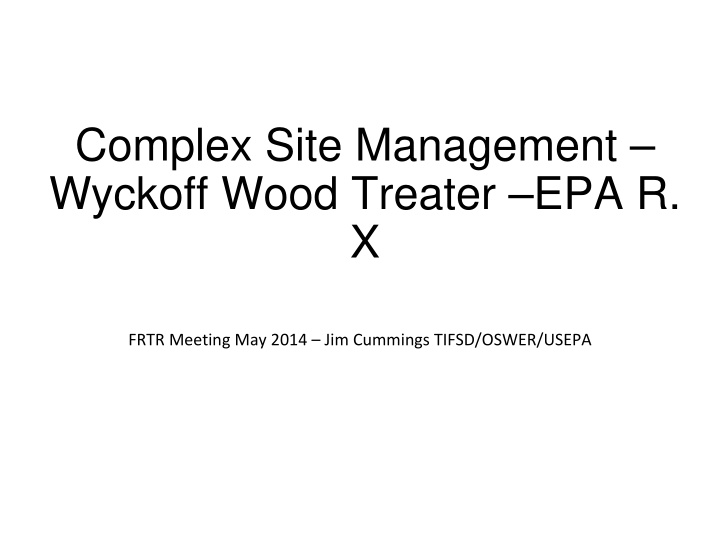



Complex Site Management – Wyckoff Wood Treater –EPA R. X FRTR Meeting May 2014 – Jim Cummings TIFSD/OSWER/USEPA
Site History • Creosote Wood treating began in 1904, ended 1988 • One of largest wood treating facilities in the U.S. • Initially, poles treated by wrapping with burlap and asphalt • By 1910, pressure treatment with creosote / bunker oil • Wood also treated with pentacholorphenol
West Coast Wood Preserving Company ~1940
Wyckoff Facility Viewed From Ferry
Wyckoff Facility in Operation
DNAPL (Beyond ‘Sheen’) On the Beach
Wyckoff Upland Source Areas
Site Administrative History • 1971 – EPA investigated report of oil on the beach • 1984 – Unilateral Administrative Order under RCRA issued to Wyckoff Company requiring environmental investigation • 1984 – Ecology issued order requiring control of stormwater • 1987 – Site added to the Superfund List • 1987 – EPA completed Remedial Investigation • 1994 – Settlement with Pacific Sound Resources for CERCLA liability and Natural Resource Damages
Wyckoff Upland and Intertidal Setting Wyckoff Upland OU ‐ 2 and OU ‐ 4 OU ‐ 1 FFS Project Area
OU-1 FFS Project Area – East Beach Low Tide Incoming Tide
TarGOST Laser-Induced Fluorescence NAPL Investigation Method
TarGOST Response and Sediment Logs (observed)
Recent Site Activities • ROD selected Steam Enhanced Extraction (SEE), contingent upon completion of pilot study • Problematic pilot study – design flaws resulted in naphthalene crystallizing out in piping and heat exchangers • Region X subsequently proposed a containment remedy • cap • pump and treat system – operational • sheet pile wall – installed • State non ‐ concurred, Submitted ‘Generational Remedy’ Report • Mostly thermal remedies • Not the first state to be reluctant to undertake perpetual care
Components of Site Management Strategy • Revise Conceptual Site Model • ‘True’ ‘Nature and Extent’ of viscous PAH contamination • Time ‘Generational Remedy’ • ‘Reasonably time frame’ • Expand scope of Focused Feasibility Study (FFS) • Flexible, adaptive use of combination of aggressive source zone technologies w/ subsequent polishing step(s)
Conceptual Site Model (CSM) Update • Original scope – 8.5 Acres/$160M (as much as 1M gallons of contamination • Use of TarGOST LIF tool has reduced footprint to <5 acres • TarGOST able to distinguish free product from dissolved phase contamination • Hope to take advantage of discrete viscous PAH NAPL architecture • Compartmentalization of site into: • ‘Core’/’Peripheral’ and ‘Dissolved Phase Areas’ • Layers as a function of depth • Used 3 ‐ D visualization and Thiessen Polygon approach
Treatment Compartments
2-D Hot Spot Map
2-D Hot Spot Map – tilted
Cross Section A-A’
Cross Section B-B’
Cross Section C-C’
Boundary Conditions/Engineering Design Considerations Intended Use: Recreational Area • State would like to discontinue pump and treat operations within 10 years • Restoration of the Resource ‘In a reasonable time frame’ • Culmination of Upland Remedial Activities in a timeframe consistent w/ life expectancy of the sheet pile wall • Protect Lower Aquifer • Concerns re competency of aquitard
Focused Feasibility Study Underway • Expanded beyond thermal remedies to include ISS, ISCO, Bio and ‘STAR’ – an innovative smoldering technology • Tools vary in the extent to which they can be employed (semi ‐ ) surgically • Promising developments in use of Bio ‐ Sparging to address aerobically biodegradable PAHs • Medium term – convert the sheet pile wall to a PRB?
Polishing -Bay Shore MGP Site (PAHs) • OU1 – Ozone treatment system • OU2 – Eight oxygen injection systems • OU3 – Series of 21 slurry ‐ injection points – Compound slowly dissolves and releases oxygen over a time period of several months.
Challenges • Achieving requisite resolution regarding NAPL architecture • ‘Oversampling in ‘Z’ dimension, undersampling in ‘X’ and ‘Y’ • Current 3 ‐ D visualization software has limitations (‘Ban the Blob’) • Need for ‘Interpretation Before Interpolation ’ – Dr. Dave Rich • Need better insights/indicia for spatial and temporal transition between technologies • ‘How much to heat, how much to eat’… • Need better tools for predicting resource restoration timeframes • Need ‘rear guard’ tools – Long term, low/no maintenance technologies to deal w/ residual contaminants
Thank You.
Recommend
More recommend